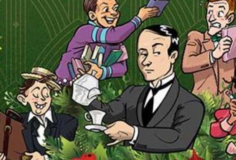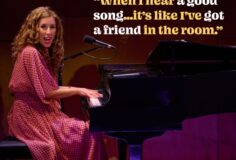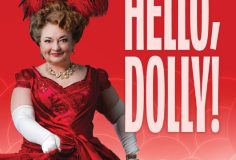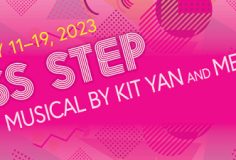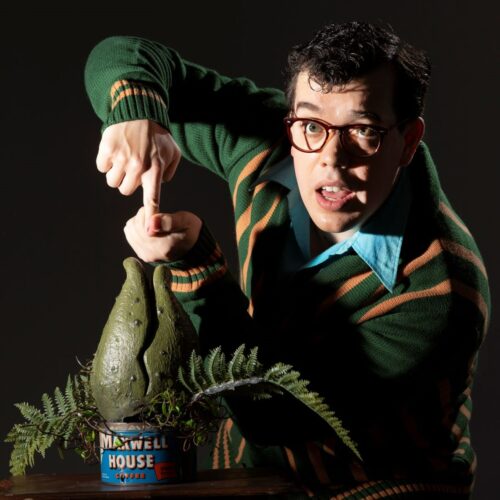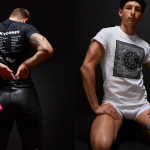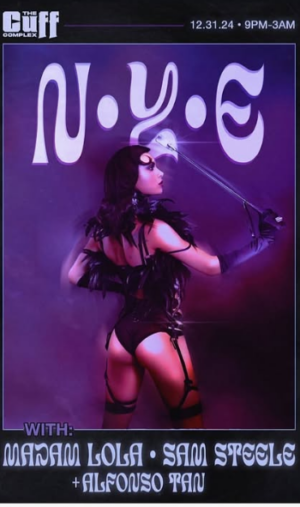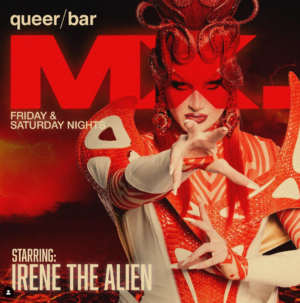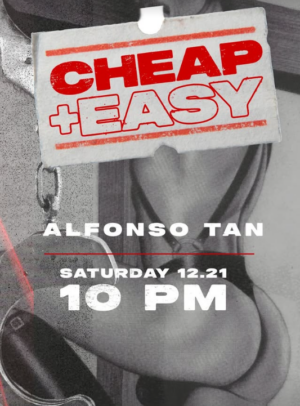Great Cast Makes for a Great, Big Show at Village’s Season Closer, “Hairspray” the Musical — In Issaquah Thru 7/1, and Everett 7/6-7/29
Shaunyce Omar, Alexandria Henderson, and Belle Pugh Among the Standouts in a Strong Cast that Makes For a Big, Fun (If Historically Misleading) Show.
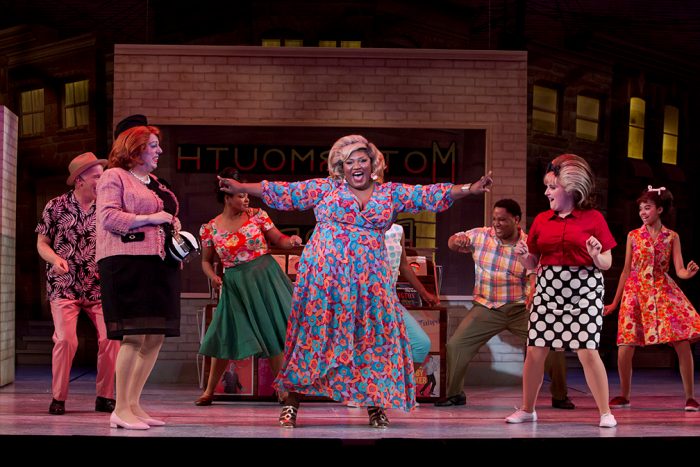
Edna Turnblad (Nick DeSantis), Motormouth Maybelle (Shaunyce Omar), and Tracy Turnblad (Callie Williams). Photo by Tracy Martin for Village Theatre.
“The ‘Corny Collins Show’ is, now and forevermore, officially integrated!” So announces Tracy Turnblad, White teenager and lead protagonist in the musical Hairspray, currently running at the Village Theatre. The show is about White teenagers and Black teenagers working together to integrate a popular TV show, over the protests of their parents, the producers, and a few snobby teenagers, and meeting with resounding victory.
If only it could be that easy.
The real “Corny Collins Show” (called the “Buddy Deane Show”) never was integrated in Baltimore. The show was all-white, except for its own “Negro Day” (referred to as “Black Monday”), when only Black dancers were allowed. According to other pieces that have looked back on it — including articles in the Atlantic and the Washington Post — the teenagers, the show’s host, and the producers were in favor of integration on the show. It was the parents and other adults who were against it, and they were the ones who given deference and got their way, even though they were uninvolved with the show. And so rather than face controversy, the show was cancelled. Sounds about like the pace of progress on social justice issues even today.
Despite feeling like a firm fixture in musical culture, Hairspray the musical is actually pretty recent. It premiered right here in Seattle at the 5th Avenue Theatre in 2002, before a hugely successful run on Broadway immediately thereafter, playing over 2,600 shows, winning eight Tony Awards, then touring all over the U.S. and globally. It is based on the 1988 “integration comedy” film by the same name, which had the same basic plot sequence and characters, but none of the catchy original tunes created for the stage version.
Beyond generalized notions of self-love and mutual acceptance, can Hairspray — an overtly political musical about racial segregation and 1960s showbiz, and which tells a false and idealized version of history — carry past the datedness of its central conflict? Can it even be relevant anymore?
The answer is yes, but it takes a bit more digging into the issues. Part of its relevance is racial representation, and representation of “other voices” — those historically stifled — more broadly. As co-Director Timothy McCuen Pigee describes in the program notes:
“[R]epresentation means everything, especially if you see so little of yourself reflected back. The protagonists in Hairspray are struggling for just that; an opportunity to see themselves reflected as fully realized human beings in a world that institutionally excludes and minimizes them.”
Hairspray is therefore also about persistent themes of power: who belongs, who is outcast, and who decides. It’s about the educational systems’ propensity to write off minority students as either low-aptitude or high-problem. And it’s about the use of one’s relative power, in whatever form it exists (wealth, physical appearance, skin color, education, position, connections), to change systems to shed systemic powers’ force over those being oppressed by them. Today’s youth (and others who pay attention) will also note its relevance to modern, mass-scale bullying epidemics — here, played out over social media; there, played out over popular TV’s “in-crowd.”
In conjunction with the Village production, there’s not much attention given to any of that — the real story or the modern parallels. In addition to the above Director’s Note, the program contains one page of historical context (events of the 1950s and ‘60s) way back on page 19, some of which describes NASA and popular culture of the time, and other pieces that approach segregation, police brutality targeting protesters, and other unsavory aspects of the era. But there’s no mention, there or elsewhere, even of the “Buddy Deane Show” on which “Corny Collins” was based, or its actual fate (cancellation, avoiding integration).
As for issues of representation, inequities of power, and bullying, the ones who pick up on the parallels are likely the ones already thinking about them — preaching to the choir. Still, having underrepresented stories and beliefs raised and affirmed regularly on stage is not a bad thing, especially when they are, by definition, uphill battles against the more represented and powerful.
And now, of course, the Village production itself.
It’s great. Hairspray demands a big production, and Village puts that on nicely. The production is endowed with great, catchy songs that are endearing right away: songs like “Good Morning Baltimore,” “Welcome to the ‘60s,” “Big, Blonde & Beautiful,” and “You Can’t Stop the Beat.” Those no doubt were a reason for the show’s success, and the Village performers do them justice.
For the set, Hairspray requires a great many different scenes — the Turnblads’ house, the joke shop downstairs, Penny’s house, the school and schoolyard, the studios, the record shop, the jail and solitary, and more. The set team (with Scenic Designer Carey Wong) did a nice job covering all its needs, and included fun details (the whimsical faces in the joke shop sign, for example) that give the right feeling to each scene. Just as importantly, the sets facilitate quick and painless (for the audience at least!) changes from scene to scene, which in turn keeps the scenes moving along. (I will note that because there’s so much going on, it plays to the margins of a very wide set — so you’re best to avoid seats on the balcony aisles, which have limited visibility around the stage edges.)
For costumes, Designer Alex Jaeger kept things largely period-appropriate, but with choices much bolder than I remember in various other versions. Most of them worked wonderfully (Motormouth’s, Edna’s, and Tracy’s are particular standouts), though a couple of them seemed pretty out there (one each on Edna and Tracy, both of them involving bright orange). Overall, they were fun, they were loud, and they worked — and somehow the actors managed to get in and out of them very quickly.
All of the production elements work, but it’s primarily Village’s attention to casting that makes the production a great one. With a cast of around 26 members, the stage is frequently full of performers, whether dancing (mostly, such as on the Corny Collins Show or at the school dance) or acting (occasionally, such as at the protest for integration) — though the most sustained acting usually occurs in smaller scenes.
The theatre has proven its casting ability in show after show recently, both in finding relatively little-known actors who are great performers, and in recruiting top talent out for long runs at its Issaquah and Everett theatres. (They may as well be in Wenatchee, to hear some describe it. It’s really not that far … except the traffic to Everett ….)

Jason Kappus (Corny Collins), Callie Williams (Tracy Turnblad), Carly Squires Hutchison (Council Member), Ethan Carpenter (Link Larkin), and Jasmine Jean Sim (Council Member) Hairspray Production photo. © 2018 Mark Kitaoka. Property of Village Theatre.
The star of the show, Tracy Turnblad, is a “pleasantly plump” White teenager, who is passionate about The Corny Collins Show, its heartthrob Link Larkin (who is dating the show’s mean girl in chief, Amber Von Tussle), dancing (especially moves she learns from the Black teenagers who are with her in detention and then special ed), and making “every day ‘Negro Day,’” the day on which the show allows Black performers, though never Black and White on the same day). Tracy is well-played by Callie Williams, a relative newcomer, who exudes Tracy’s bold and likable personality. Tracy’s pursuit, Link (Ethan Carpenter) is suitably self-absorbed-but-nice (these “get the guy” storybook guys rarely leave me enamored, and he mostly just wants a record deal). Williams and Carpenter have a particularly impressive scene in the “I Can Hear the Bells” number, in which Link is frozen like a mannequin for what seems like an eternity, while Tracy poses him to fit her daydreams.
Tracy’s parents, Edna (Nick DeSantis) and Wilbur (Peter Crook) are tender and funny together, and have some particularly sweet scenes — their affirmation of love together, in “You’re Timeless to Me” — is a standout. DeSantis’s version of Edna is more subdued than she’s often played — more like the 1988 movie version — and at first it feels like there’s something missing, since Edna’s over-the-top character is one of the funnier elements of some productions. But it can easily go over the edge into too cheap, especially if the role is just played as bad drag instead of good gaudy. Happily, Edna does get her over-the-top moments to shine later on in the show. But in the meantime, DeSantis does a nice job avoiding caricature and keeping Edna a remarkable human, as Tracy’s sensitive, hard-working, devoted, protective, and socially conscious mom (don’t we all need one of those?), which adds a depth of family life and love, rather than a constant sideshow act.

Edna Turnblad (Nick DeSantis) and Wilbur Turnblad (Peter Crook). Photo by Mark Kitaoka for Village Theatre.
Both Tracy and Edna are written as large characters — in both personality and figure. For the Village casting, as my friend described it, “They aren’t even that big. What, did Seattle run out of fat actors?” True enough. It’s worth asking whether casting bigger would have served the roles better.
The script gives none of the Black characters nearly as much attention or personality development as the Turnblads, so there’s little detail to offer on their family dynamics. Seaweed J. Stubbs is the primary character among the Black teenagers, though his main role revolves around being the love interest of Tracy’s best friend (Penny Pingleton, whose mom is best described as ridiculous, controlling, and panic-stricken with fear of Black people … or in a word, racist). Seaweed is played by Charles Simmons, a good actor with a strong voice and last seen at Village in Dreamgirls; but he is noticeably too old for the role of a high schooler which, when the love interest is also a high schooler, gets a little weird. Seaweed is joined by The Dynamites (an excellent vocal trio of Alexandria Henderson, Stephanie Anne Johnson, and Elena Joyner); and his little sister Little Inez, played by Belle Pugh (an actual teenager and fantastic talent already, and an acting-singing-dancing triple-threat), and in rotation with Jayden Terry-Olson as alternate, also a strong, versatile, and young talent (but perhaps too tall for this particular role).
But the star of the show’s Black characters is the family matriarch, Motormouth Maybelle — already a star in Tracy and Penny’s eyes, since she hosts the “Corny Collins Show” for its special “Negro Day” — played by stellar actor/singer Shaunyce Omar. (Omar performed previously in Village’s production of My Heart Is the Drum, as well as Book-It’s stellar-is-an-understatement adaptation of I Know Why the Caged Bird Sings, 5th Avenue Theatre’s otherwise-lukewarm Pajama Game, and others.) Motormouth doesn’t enter the action until nearly the second act, which is a bummer — but she chiefly shoulders several scenes when she does. Omar is just the right performer for the role of Motormouth, who’s bold but realistic, open but protective, a revolutionary waiting for the right time to shrug off daily sensibility. (All of which come with great outfits Omar wears well — and with two costume changes in short order.) If anyone ever rewrites this show (again) — I gotta have more Motormouth.
Hairspray at Village is a great production of a favorite musical, with fun design work, loads of catchy songs, and a great big talented cast. Rather than take its facts and neat resolution at face value, however, I hope audiences will take more with them — an inspiration to question how the issues raised in Hairspray crop up still today.
Bonus Round
In a big talented cast, here are three to watch — in this show and future performances:
Belle Pugh: Pugh is a sophomore in high school and already playing varied and difficult roles on some impressive stages — and knocking them out of the park. As Little Inez (one of two alternating actors playing her), her acting is charming yet bold, her dancing keeps up with fast numbers and a crowded stage, and she gets to show off her excellent voice, if only in quick bits. In Macha Theatre Works’ recent production of Smoke & Dust, Pugh’s character owned the show even from offstage, as a teenage YouTube star who communicated through video feed, and ended up a victim of horrible online bullying affronts. (Interestingly, the peer acceptance/bullying theme arose in Hairspray, too, albeit in a less pivotal role than in Smoke & Dust.) Pugh has shown great versatility in that more subdued, serious role, alongside her big musical performance here.
Alexandria Henderson: Henderson performs in Hairspray only in unnamed supporting roles (as one of three Dynamites, and part of the Ensemble), but she lights up the stage whenever she’s on it. She’s one of two actors I’ve seen over multiple performances whose expressions alone can grab and hold my attention, however many actors are on stage with her. (Chantal DeGroat is the other.) Henderson’s dancing and movements are fluid and effortless. Also, she’s got one stellar voice — underused in this performance, perhaps, but it shined clear and bright in the Dynamites performances (“Welcome to the ‘60s,” for example), and when backing Motormouth Maybelle (Shaunyce Omar) in “I Know Where I Been.” Henderson has performed recently with smaller companies (Twelfth Night Productions, Showtunes, Seattle Musical Theatre, Tacoma Musical Playhouse), but increasingly is in larger productions with the Village and 5th Avenue Theatre. It seems like wherever she performs, she’s a standout.
Shaunyce Omar: Village holds a special spot in my heart for first introducing me to the stage and vocal talents of Shaunyce Omar who, even in a supporting role with little stage time (in the 2016 production of My Heart Is the Drum), left a lasting impression. Apparently she did at the Village, too — you can find a towering production photo of Omar with Claudine Mboligikpelani Nako above the Issaquah theatre’s main staircase. Omar’s ability to command a show and bring down the house when she lets her vocals carry is unmatched and unrivaled. When she lets loose, you just want to smack something — two years and several shows later, and I still get massive chills when she sings. Although known for her vocals, her acting is spot-on, too — and with a unique ability to win almost anyone over with one sideways glance and a well-placed poignant zinger, whether comedic or deadly serious. Find me anyone else in town with those powers — I bet you won’t.
Hairspray runs through 7/1 at the Village Theatre (Issaquah location), followed by performances 7/6 through 7/29 at its Everett location (various times, see Issaquah schedule and tickets here, and Everett schedule and tickets here). Tickets are up to $80; half-price rush available for military, seniors, and industry/TPS members, 30 minutes before showtime; limited number of discount advance tickets available to all by purchasing on Goldstar. (If you want a mini “try before you buy,” there’s a short video of performance clips on the page at the ticket links above.)


